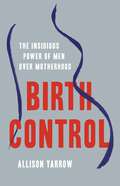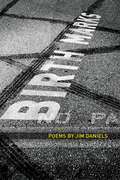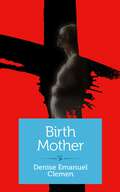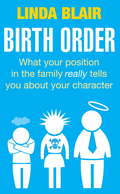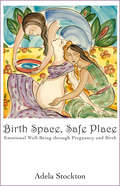- Table View
- List View
Birth Control: The Insidious Power of Men Over Motherhood
by Allison Yarrow"Supported by ample data and suffused with anger,&” an award-winning journalist &“convincingly recasts this country&’s maternal health care system as needlessly dehumanizing&” (New York Times Book Review). Modern medicine should make pregnancy and childbirth safer for all. But in Birth Control, award-winning journalist Allison Yarrow reveals how women are controlled, traumatized, injured, and even killed because of the traditionalist practices of medical professionals and hospitals. Ever since doctors stole control of birth from midwives in the 19th century, women have been steamrolled by a male-dominated medical establishment that has everyone convinced that birthing bodies are inherently flawed and that every pregnancy is a crisis that it alone can &“solve.&” Common medical practices and procedures violate human rights and the law, yet take place daily. Misogyny and racism, not scientific evidence and support, shape the overwhelming majority of America&’s four million annual births. Drawing on extensive reporting, expert interviews, an original survey of 1,300 mothers, and her own personal experiences, Yarrow documents how modern maternal health care is insidiously, purposefully designed to take power from women to the detriment of their physical and mental health—not just during labor, but for years after. She then shows a better way, exploring solutions both cutting-edge and ancient to—finally—return power and control to birthing people. Full of urgent insights and heartfelt emotion, Birth Control is an explosive call to action.
Birth Crisis
by Sheila KitzingerOne new mother in twenty is diagnosed with traumatic stress after childbirth. In Birth Crisis Sheila Kitzinger explores the disempowerment and anxiety experienced by these women. Key topics discussed include: increasing intervention in pregnancy the shift in emphasis from relationships to technology in childbirth how family, friends and professional caregivers can reach out to traumatized mothers how women can work through stress to understand themselves more deeply and grow in emotional maturity how care and the medical system needs to be changed. Birth Crisis draws on mothers' voices and real-life experiences to explore the suffering after childbirth which has, until now, been brushed under the carpet. It is a fascinating and useful resource for student and practising midwives, all health professionals, and women and their families who want to learn how to overcome a traumatic birth.
Birth Day: A Pediatrician Explores the Science, the History, and the Wonder of Childbirth
by Mark SloanA seasoned pediatrician explores why, in the 21st century, having a baby is still so hard. He looks at other delivery room events, from the intense moments immediately preceding and following birth to an eye-popping history of painkillers, birthing methods, and infant resuscitation.
Birth Defects in India: Epidemiology and Public Health Implications
by Anita KarThis book presents the epidemiology of birth defects and their public health and social implications in India. As neglected childhood disorders, birth defects remain invisible in global maternal and child health dialogues. Birth defects services are emerging in India. This book approaches birth defects from a public health perspective, identifying the core functions of a birth defects service. Keeping in mind the complex task of providing multidisciplinary services for children with disabilities and complex medical conditions, the book examines the basic public health activities that have been put in place to address these conditions in India. The book describes birth defects surveillance and the challenges of acquiring accurate and timely data on birth defects against the background of India’s mixed health system. It discusses opportunities for prevention of birth defects and describes the structure and function of an emergent genetic service. It explores issues related to an integrated service for children with special healthcare needs, such as screening, early intervention, and rehabilitation. Furthermore, it describes the impact of these conditions on caregivers, including birth defects stigma. This book not only addresses a knowledge gap in the field of public health in India, but also explores the broader issues of services for children with disabilities and disabling conditions in low and low-middle income settings where access to health care is not universal. Given the depth and breadth of its coverage, the book offers an essential resource for birth defects researchers, researchers in the field of maternal and child health, public health/ global health, disability researchers, and researchers from the fields of rehabilitation sciences, nursing and anthropology. This book will be a valuable read for social medicine/community medicine departments, global health courses, and public health schools in India and other low middle-income countries.
Birth Figures: Early Modern Prints and the Pregnant Body
by Rebecca WhiteleyThe first full study of “birth figures” and their place in early modern knowledge-making. Birth figures are printed images of the pregnant womb, always shown in series, that depict the variety of ways in which a fetus can present for birth. Historian Rebecca Whiteley coined the term and here offers the first systematic analysis of the images’ creation, use, and impact. Whiteley reveals their origins in ancient medicine and explores their inclusion in many medieval gynecological manuscripts, focusing on their explosion in printed midwifery and surgical books in Western Europe from the mid-sixteenth to the mid-eighteenth century. During this period, birth figures formed a key part of the visual culture of medicine and midwifery and were widely produced. They reflected and shaped how the pregnant body was known and treated. And by providing crucial bodily knowledge to midwives and surgeons, birth figures were also deeply entangled with wider cultural preoccupations with generation and creativity, female power and agency, knowledge and its dissemination, and even the condition of the human in the universe. Birth Figures studies how different kinds of people understood childbirth and engaged with midwifery manuals, from learned physicians to midwives to illiterate listeners. Rich and detailed, this vital history reveals the importance of birth figures in how midwifery was practiced and in how people, both medical professionals and lay readers, envisioned and understood the mysterious state of pregnancy.
Birth Marks
by Jim DanielsIn Birth Marks, Jim Daniels examines how our origins mark us forever. From Detroit to Pittsburgh, he explores the lives of ordinary people in a world which often seems tilted against them. His tough, unflinching poems recount family myths, urban decay, his own lies, and the struggle for survival in a post-industrial world as the economy crumbles around us.
Birth Marks (American Poets Continuum)
by Jim DanielsIn Birth Marks, Jim Daniels examines how our origins mark us forever. From Detroit to Pittsburgh, he explores the lives of ordinary people in a world which often seems tilted against them. His tough, unflinching poems recount family myths, urban decay, his own lies, and the struggle for survival in a post-industrial world as the economy crumbles around us.
Birth Matters
by Ina May Gaskin Ani DifrancoRenowned for her practice's exemplary results and low intervention rates, Ina May Gaskin has gained international notoriety for promoting natural birth. She is a much-beloved leader of a movement that seeks to stop the hyper-medicalization of birth--which has lead to nearly a third of hospital births in America to be cesarean sections--and renew confidence in a woman's natural ability to birth.Upbeat and informative, Gaskin asserts that the way in which women become mothers is a women's rights issue, and it is perhaps the act that most powerfully exhibits what it is to be instinctually human. Birth Matters is a spirited manifesta showing us how to trust women, value birth, and reconcile modern life with a process as old as our species.
Birth Models That Work
by Lesley Barclay Robbie E. Davis-Floyd Betty-Anne Daviss Jan TrittenThis groundbreaking book takes us around the world in search of birth models that work in order to improve the standard of care for mothers and families everywhere. The contributors describe examples of maternity services from both developing countries and wealthy industrialized societies that apply the latest scientific evidence to support and facilitate normal physiological birth; deal appropriately with complications; and generate excellent birth outcomes--including psychological satisfaction for the mother. The book concludes with a description of the ideology that underlies all these working models--known internationally as the midwifery model of care.
Birth Mother: A Memoir
by Denise Emanual ClemenPregnant from her first sexual encounter, a teenager living in a town of 3,000 Catholics keeps her secret from everyone until six weeks before the baby&’s due date. Hustled out of town and hidden in the Iowa countryside within hours of finally confiding in her mother, she concocts a scheme that will allow her to raise her child, but can she win over any of the people who might help her? As her pregnancy and its looming consequences unfold, she realizes that her life of lies and secrets has only just begun.
Birth Mothers and Transnational Adoption Practice in South Korea: Virtual Mothering (Critical Studies in Gender, Sexuality, and Culture)
by Hosu KimThis book illuminates the hidden history of South Korean birth mothers involved in the 60-year-long practice of transnational adoption. The author presents a performance-based ethnography of maternity homes, a television search show,an internet forum, and an oral history collection to develop the concept of virtual mothering, a theoretical framework in which the birth mothers' experiences of separating from, and then reconnecting with, the child, as well as their painful,ambivalent narratives of adoption losses, are rendered, felt and registered. In this, the author refuses a universal notion of motherhood. Her critique of transnational adoption and its relentless effects on birth mothers' lives points to the everyday, normalized, gendered violence against working-class, poor, single mothers in South Korea's modern nation-state development and illuminates the biopolitical functions of transnational adoption in managing an "excess" population. Simultaneously, her creative analysis reveals a counter-public, and counter-history, proposing the collective grievances of birth mothers.
Birth Notes: A Memoir of Recovery
by Jessica Cornwell'I SAVOURED EVERY WORD' ABI DARÉ A REDEMPTIVE TALE OF THE POWER AND WISOM OF WOMEN'S BODIES' LEAH HAZARD'MAGNIFICENT: A WORK OF TRUTH' SUSIE ORBACH'FILLED ME WITH HOPE' DR ELINOR CLEGHORN'SO MANY WOMEN WILL FEEL LESS ALONE AFTER READING THIS BOOK' KATIE WARD Following the birth of her first children, twin boys, Jessica Cornwell collapsed in a fever. Rushed back to hospital, she was initially dismissed, before a life-threatening infection was diagnosed. Alone, recovering, watching her body bruise and break, a curious thing happened: she stopped feeling.At home, the numbness remained. Nursing her boys through jaundice, learning to breastfeed, slowly re-emerging into a world where other mothers seemed to cope, Jessica hid her secret - she felt no love, only fear. Worse, vivid memories began to surface, of moments in her past she thought buried.Jessica began to name, one by one, the shadows that returned to haunt her first year as a mother. And in claiming back the words, she fought to claim back her life and the love she bore her young family.Birth Notes is the story - luminous, breathtaking and courageous - of forging a self from fragments. With eloquent rage and searing honesty, it speaks for the unvoiced and shines a light on maternal mental health. It is the love story of a mother for her children and a woman for herself.
Birth Notes: A Memoir of Recovery
by Jessica Cornwell'I SAVOURED EVERY WORD' ABI DARÉ A REDEMPTIVE TALE OF THE POWER AND WISOM OF WOMEN'S BODIES' LEAH HAZARD'MAGNIFICENT: A WORK OF TRUTH' SUSIE ORBACH'FILLED ME WITH HOPE' DR ELINOR CLEGHORN'SO MANY WOMEN WILL FEEL LESS ALONE AFTER READING THIS BOOK' KATIE WARD Following the birth of her first children, twin boys, Jessica Cornwell collapsed in a fever. Rushed back to hospital, she was initially dismissed, before a life-threatening infection was diagnosed. Alone, recovering, watching her body bruise and break, a curious thing happened: she stopped feeling.At home, the numbness remained. Nursing her boys through jaundice, learning to breastfeed, slowly re-emerging into a world where other mothers seemed to cope, Jessica hid her secret - she felt no love, only fear. Worse, vivid memories began to surface, of moments in her past she thought buried.Jessica began to name, one by one, the shadows that returned to haunt her first year as a mother. And in claiming back the words, she fought to claim back her life and the love she bore her young family.Birth Notes is the story - luminous, breathtaking and courageous - of forging a self from fragments. With eloquent rage and searing honesty, it speaks for the unvoiced and shines a light on maternal mental health. It is the love story of a mother for her children and a woman for herself.
Birth Of A Worldview: Early Christianity In Its Jewish And Pagan Context
by Robert DoranThis book explores how early Christian intellectuals expressed their understanding of the cosmos. It reviews the role of women, documentation of the vitality and influence of Jewish intellectual thought, and the continuing impact of Greek intellectual thought during Christianity's formative years.
Birth Of Modern Counterfire - The British And American Experience In World War I
by Major William M. CampseyThis study investigates the original needs for and development of counterfire techniques in World War I. Concentrating on the experiences of the British and the Americans, the examination explores techniques of counterfire and their failures or successes.The first chapter investigates why World War I was the first war in which modern counterfire techniques were employed. Chapter 2 describes the British experience. Chapters 3 & 4 explain how the Americans trained for and fought in the war. The last chapter analyses those techniques and principles of action that had relevance for both nations.The study concludes that several techniques were necessary in World War I to suppress enemy artillery. First, efforts to destroy enemy artillery before battles were not as successful as efforts to neutralize it for the duration of the battle. Second, with the enormity of details necessary to collect intelligence, assign targets, preposition ammunition, and execute the program of fire, competent staff work became critical. Third, the intelligence procedures developed in position warfare were insufficient to suppress enemy artillery as the battle line moved progressively forward. Suppression of all terrain in the zone of operations that was capable of holding enemy artillery became necessary. Finally, artillery organization and control must be centralized.The study also identifies two techniques necessary to exploit successful counterfire. First, surprise over the enemy would invariably gain the initiative. The enemy guns would not recover from the surprise for the duration of time that neutralization fires continued. Second, counterfire must be integrated into the overall fireplan and the infantry scheme of maneuver. It did the commander no good if counterfire was successful only to fail to exploit that success with maneuver.
Birth Order Blues: How Parents Can Help Their Children Meet the Challenges of Birth Order
by Meri WallaceBirth order has a powerful effect on children's emotional development, on their self-esteem, and on their sense of well-being. The youngest child, the firstborn, the middleborn, twins, and the only child all have specific birth order issues that, if not atted to early on, can impair their functioning and their interpersonal relations at home and at school, and can follow them into adulthood. Parental birth order, too, plays an important role, as do such other factors as gender and family size. To understand these birth order blues, the author, an expert in parent-child relationships, first raises parents' awareness of the impact of birth order upon children. She then shows how to identify their children's birth order problems, often disguised by behaviors such as underachievement or aggression, and suggests how they can resolve these issues and prevent negative behavioral patterns from developing.
Birth Order: What your position in the family really tells you about your character
by Linda BlairOn the basis of over 25 years' clinical experience and psychological research, Linda Blair reveals how your birth order position, as well as the spacing between you and your siblings and the sex of your siblings, impact your childhood, your adult life and your relationships.Packed with new research and written in a lively, personal style, Birth Order will inform and intrigue. By reading this unique book you will quickly understand yourself, your family and your partner better. It will also shed light on the dynamics of your other relationships, explain why you may repeat patterns within relationships, and suggest helpful strategies for dealing with other people. Chapters cover birth order and what being the eldest, middle, or youngest child reveals about you, the effect of large or small age gaps between you and your siblings, family size, the sex of your siblings, parental attitudes to each child, being an only child, being a twin, the impact of step-siblings, and much more.
Birth Order: What your position in the family really tells you about your character
by Linda BlairOn the basis of over 25 years' clinical experience and psychological research, Linda Blair reveals how your birth order position, as well as the spacing between you and your siblings and the sex of your siblings, impact your childhood, your adult life and your relationships.Packed with new research and written in a lively, personal style, Birth Order will inform and intrigue. By reading this unique book you will quickly understand yourself, your family and your partner better. It will also shed light on the dynamics of your other relationships, explain why you may repeat patterns within relationships, and suggest helpful strategies for dealing with other people. Chapters cover birth order and what being the eldest, middle, or youngest child reveals about you, the effect of large or small age gaps between you and your siblings, family size, the sex of your siblings, parental attitudes to each child, being an only child, being a twin, the impact of step-siblings, and much more.
Birth Partner Handbook
by Carl JonesThe Birth Parter Handbook is a concise, contemporary guide for today's birth partners, showing them exactly what they can do to help create a positive birth experience, whether the mother gives birth naturally or with medication, at home, in a childbearing center, or in a hospital. With a special emphasis on the psychological changes of labor, this guide also introduces a new approach to understanding labor made popular through the author's nationwide childbirth workshops, called the "laboring mind response." Birth partners will gain new insight into the mother's altered state of mind and altered behavior during labor, and be given an easy-to-follow, eight-step method that teaches the mind to cooperate with the body and will help make childbirth less stressful and more natural for the mother.
Birth Plans For Dummies
by Rachel Gurevich Sharon Perkins RnThe easy, trusted way to develop a birth planAs an expectant mother and parent, navigating all of the information and options for labor and delivery can be cumbersome and confusing. Birth Plans For Dummies, is the ultimate resource guide to help you understand, develop, and implement a plan for the birth of your baby.A birth plan is a communication tool for expectant mothers and those involved in the delivery of a child. The plan explains the mother's preferences for labor and delivery and eliminates any confusion. There are a wide variety of methods, strategies, and techniques available to pregnant women preparing for delivery--and this hands-on, friendly guide covers them all.Covers choosing the setting and method that best fits the mothers needs and wishesInforms expectant parents about the numerous pain management and labor intervention optionsProvides instruction on developing and writing a birth plan and putting it into actionIf you are an expectant mother or parent looking for a guide to help develop a plan for the birth of your child, then Birth Plans For Dummies is the perfect book for you.
Birth School Metallica Death, Volume 1: The Biography
by Paul Brannigan Ian WinwoodThere has never been a hard rock band like Metallica. The California quartet has sold more than 100 million albums worldwide, won nine Grammy Awards, and had five consecutive albums hit number one on the Billboard charts. But Metallica's story, epic in scope, is a tale about much more than sales figures and critical acclaim, and their journey from scuzzy Los Angeles garages to the world's most storied stadiums has been dramatic and painful, their gigantic successes often shot through with tension, tragedy, loss, and controversy.Birth School Metallica Death is the definitive story of the most significant rock band since Led Zeppelin. Volume 1 covers the band's formation up to their breakthrough eponymous fifth album, aka "The Black Album." The intense and sometimes fraught relationship between aloof-yet-simmering singer, chief lyricist, and rhythm guitarist James Hetfield and the outspoken and ambitious drummer Lars Ulrich is the saga's emotional core. Their earliest years saw the release of three unimpeachable classics-Kill 'Em All, Ride the Lightning, and Master of Puppets-genre-defining masterpieces that took hard rock to a new level, both artistically and commercially. During these tumultuous times, the band persevered through line-up changes when guitarist Dave Mustaine was replaced by Kirk Hammet, and their bass player, the beloved Cliff Burton, was tragically killed in a bus crash while on tour in Europe.But it was the breakthrough of ...And Justice for All that rent the fabric of the mainstream, hitting the top of the charts without benefit of radio airplay or the then-crucial presence on MTV. And finally in 1991, with the release of their fifth studio album, nicknamed "The Black Album," Metallica hit the next level-five hit singles including their best-known songs "Enter Sandman" and "Nothing Else Matters"-and their first album atop the Billboard charts.In Birth School Metallica Death, veteran music journalists and Metallica confidants Paul Brannigan and Ian Winwood detail this meteoric rise to international fame in an epic saga of family, community, self-belief, the pursuit of dreams, and music that rocks. Told through first-hand interviews with the band and those closest to them, the story of Metallica's rise to the mainstream has never been so vividly documented.
Birth Settings in America: Outcomes, Quality, Access, And Choice
by Engineering Medicine National Academies of SciencesThe delivery of high quality and equitable care for both mothers and newborns is complex and requires efforts across many sectors. The United States spends more on childbirth than any other country in the world, yet outcomes are worse than other high-resource countries, and even worse for Black and Native American women. There are a variety of factors that influence childbirth, including social determinants such as income, educational levels, access to care, financing, transportation, structural racism and geographic variability in birth settings. It is important to reevaluate the United States' approach to maternal and newborn care through the lens of these factors across multiple disciplines. Birth Settings in America: Outcomes, Quality, Access, and Choice reviews and evaluates maternal and newborn care in the United States, the epidemiology of social and clinical risks in pregnancy and childbirth, birth settings research, and access to and choice of birth settings.
Birth Space, Safe Place
by Adela StocktonFocusing on the wide spectrum of feelings that may arise when with child, this companion to the emotional journey caused by pregnancy, birth, and early parenting offers informative resources and homeopathic remedies for both parents-to-be and childbirth practitioners. With advice about laying fears to rest, keeping birth gentle, and protecting the baby-moon, this hand-held doula helps couples face the choices on their journey to parenthood as well as adjust to their new roles as parents, all the while emphasizing the spiritual journey of birth by putting the mother's emotional and spiritual needs before her physical requirements. Proposing that the experience of childbirth has the capacity to nourish rather than replete the soul, the book encourages women to take responsibility for their own birthing process and to surrender to their own instinctive powers rather than to those of medical intervention.
Birth Strike: The Hidden Fight over Women's Work
by Jenny BrownWhen House Speaker Paul Ryan urged U.S. women to have more children, and Ross Douthat requested "More babies, please," in a New York Times column, they openly expressed what U.S. policymakers have been discussing for decades with greater discretion. Using technical language like "age structure," "dependency ratio," and "entitlement crisis," establishment think tanks are raising the alarm: if U.S. women don't get busy having more children, we'll face an aging workforce, slack consumer demand, and a stagnant economy. Feminists generally believe that a prudish religious bloc is responsible for the protracted fight over reproductive freedom in the U.S., and that politicians only attack abortion and birth control to appeal to those "values voters." But hidden behind this conventional explanation is a dramatic fight over women's reproductive labor. On one side, elite policymakers want an expanding workforce reared with a minimum of employer spending and a maximum of unpaid women's work. On the other side, women are refusing to produce children at levels desired by economic planners. By some measures our birth rate is the lowest it has ever been. With little access to childcare, family leave, health care, and with insufficient male participation, U.S. women are conducting a spontaneous birth strike. In other countries, panic over low birth rates has led governments to underwrite childbearing and childrearing with generous universal programs, but in the U.S., women have not yet realized the potential of our bargaining position. When we do, it will lead to new strategies for winning full access to abortion and birth control, and for improving the difficult working conditions U.S. parents now face when raising children.
Birth Trauma and Perinatal Brain Damage
by Vasily Vasilievich Vlasyuk<p>This book focuses on traumatic birth injuries, predominantly of the skull and brain, as well as hemorrhagic and ischemic disorders of cerebral circulation in fetuses and newborns, providing information on each condition’s classification, incidence, etiology and pathogenesis, pathomorphology, clinic, diagnostics, prognosis, and complications. It discusses the configuration (molding) of the head, venous congestion, displacements of cranial bones, ruptures of the cerebellar tentorium during labor, and the compression of the skull and brain damage caused by obstetric operations and asynclitic insertion of the head, while also describing the importance of the periosteal stagnation of the skull to assess the delivery and explanation of tentorium tears. Intracranial hemorrhages are considered in detail, taking into account the role of the traumatic factor in their occurrence and hypoxic-ischemic brain lesions (periventricular leukomalacia, selective neuronal necrosis, multicystic encephalomalacia, etc.). <p>Lastly, it offers the world’s first explanation of why tentorium tears occur most frequently in the left half, providing an original classification of damaged tentoria, subarachnoid and intraventricular hemorrhages, and the degree of configuration of the head in childbirth. <p>Given the depth and breadth of its coverage, the book offers an essential resource for neonatologists, obstetricians-gynecologists, perinatologists, pediatric neurologists, pathologists, pediatricians, forensic experts and neuroimaging professionals.</p>
